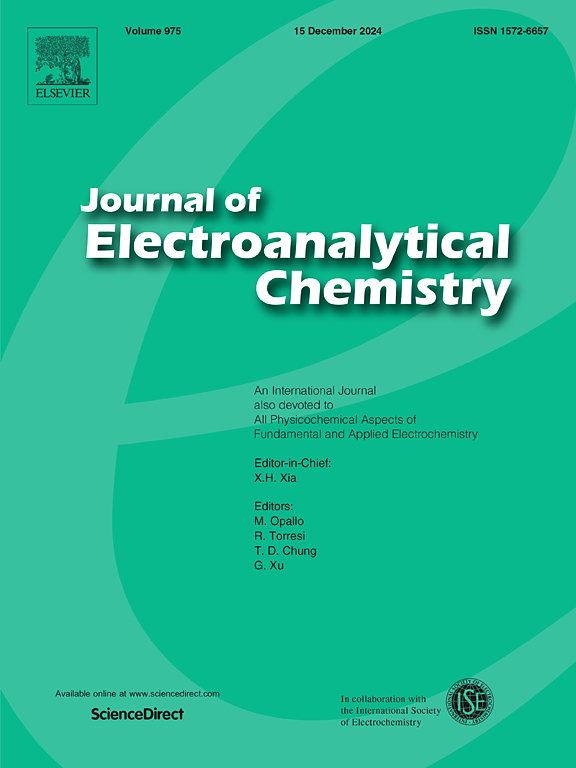Interfacial Ohmic contact engineering in MoSe2/Ti3C2 Heterostructures for high-performance sodium-ion capacitors
IF 4.1
3区 化学
Q1 CHEMISTRY, ANALYTICAL
引用次数: 0
Abstract
The development of sodium-ion capacitors (SICs) is hindered by the kinetic mismatch between sluggish ion diffusion in battery-type anodes and rapid surface reactions in capacitive cathodes. Herein, a MoSe2/Ti3C2 heterostructure with ohmic contact interfaces is synthesized via a facile solvothermal method, which simultaneously improve charge transfer kinetics and structural stability. Density functional theory (DFT) calculations reveal that the MoSe2/Ti3C2 interface reduces Na+ diffusion energy barriers while providing efficient electron transport pathways. Notably, the MoSe2/Ti3C2 heterostructure as a sodium-ion battery (SIB) anode delivers a high reversible capacity of 506.2 mAh g−1 at 0.1 A g−1 and retains a capacity of 314.2 mAh g−1 at 10.0 A g−1, demonstrating exceptional rate capability. When coupled with a commercial activated carbon (AC) cathode, the SIC device achieves energy densities of 101.3 Wh kg−1 at 297.8 W kg−1, retaining 26.1 Wh kg−1 even at 11.2 kW kg−1. Additionally, the device exhibits outstanding cycling stability with 97.5 % capacity retention after 5500 cycles. These results highlight the critical role of ohmic contact engineering in optimizing hybrid electrode design and provide a pathway for advancing high-performance SICs.

高性能钠离子电容器中MoSe2/Ti3C2异质结构的界面欧姆接触工程
电池型阳极中缓慢的离子扩散与电容型阴极中快速的表面反应之间的动力学不匹配阻碍了钠离子电容器的发展。本文通过简单的溶剂热法合成了具有欧姆接触界面的MoSe2/Ti3C2异质结构,同时提高了电荷转移动力学和结构稳定性。密度泛函理论(DFT)计算表明,MoSe2/Ti3C2界面降低了Na+扩散能垒,同时提供了有效的电子传递途径。值得注意的是,作为钠离子电池(SIB)阳极的MoSe2/Ti3C2异质结构在0.1 a g−1时提供了506.2 mAh g−1的高可逆容量,在10.0 a g−1时保持了314.2 mAh g−1的容量,展示了卓越的倍率能力。当与商用活性炭(AC)阴极耦合时,SIC器件在297.8 W kg - 1时获得101.3 Wh kg - 1的能量密度,即使在11.2 kW kg - 1时也保持26.1 Wh kg - 1。此外,该设备具有出色的循环稳定性,5500次循环后容量保持率为97.5%。这些结果突出了欧姆接触工程在优化混合电极设计中的关键作用,并为高性能sic的发展提供了途径。
本文章由计算机程序翻译,如有差异,请以英文原文为准。
求助全文
约1分钟内获得全文
求助全文
来源期刊
CiteScore
7.80
自引率
6.70%
发文量
912
审稿时长
2.4 months
期刊介绍:
The Journal of Electroanalytical Chemistry is the foremost international journal devoted to the interdisciplinary subject of electrochemistry in all its aspects, theoretical as well as applied.
Electrochemistry is a wide ranging area that is in a state of continuous evolution. Rather than compiling a long list of topics covered by the Journal, the editors would like to draw particular attention to the key issues of novelty, topicality and quality. Papers should present new and interesting electrochemical science in a way that is accessible to the reader. The presentation and discussion should be at a level that is consistent with the international status of the Journal. Reports describing the application of well-established techniques to problems that are essentially technical will not be accepted. Similarly, papers that report observations but fail to provide adequate interpretation will be rejected by the Editors. Papers dealing with technical electrochemistry should be submitted to other specialist journals unless the authors can show that their work provides substantially new insights into electrochemical processes.

 求助内容:
求助内容: 应助结果提醒方式:
应助结果提醒方式:


